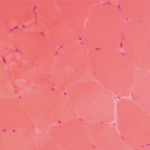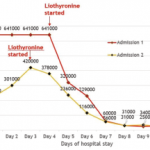A clinical advisory on the use and safety of statins standardized the terminology for statin-induced muscle-related symptoms.3 The following definitions were identified:
- Myalgia: muscle ache/weakness without creatine kinase (CK) elevation
- Myopathy: broad term for any muscle symptom or pathology
- Myositis: muscular symptoms with a CK elevation and rhabdomyolysis
- Rhabdomyolysis: muscle symptoms with marked CK elevation > 10 times the upper limit of normal (ULN) with a creatinine elevation and occasional presence of brown urine with urinary myoglobin
Mechanism
The mechanism of statin-induced myopathy has not been determined but is believed to be a class effect.1,7 There are a number of proposed mechanisms mostly involving a deficiency of one of the main synthetic products of the HMG-CoA reductase pathway. These mechanisms include impaired cholesterol synthesis with secondary abnormal myocyte membrane behavior; impaired synthesis of the compounds in the cholesterol synthesis pathway, including mevalonate and ubiquinone (coenzyme Q10 or CoQ10); or abnormalities in prenylated protein causing altered intracellular messaging.7 Although statin-induced myopathy is usually considered a noninflammatory or toxic myopathy, experimental evidence also suggests the contribution of an autoimmune reaction.7


